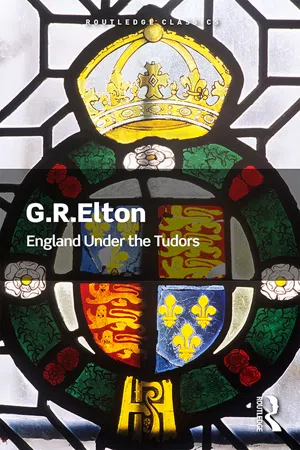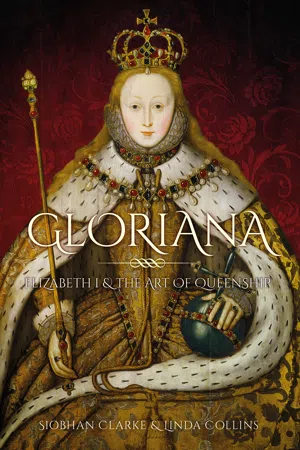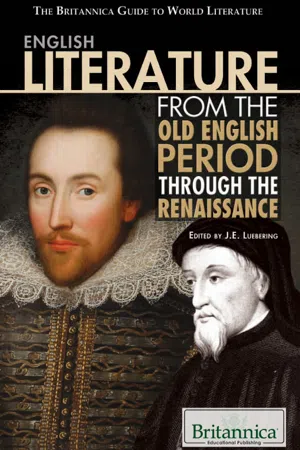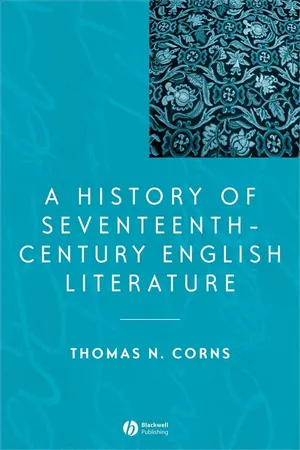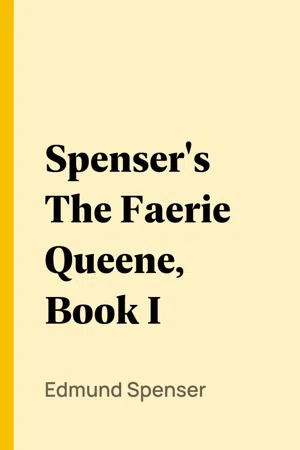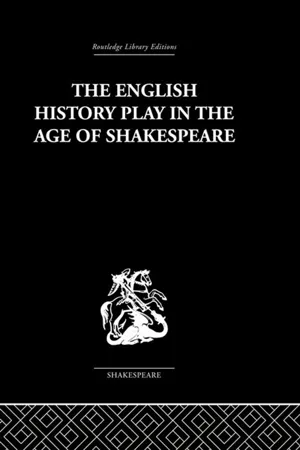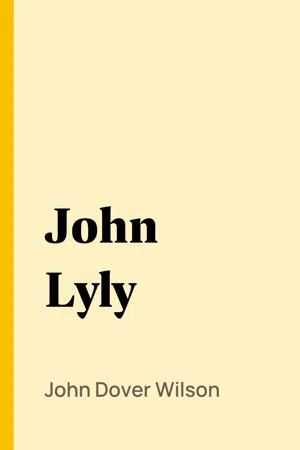Literature
Elizabethan Age
The Elizabethan Age refers to the period of English history during the reign of Queen Elizabeth I, from 1558 to 1603. It was a time of great cultural and literary achievement, with the works of William Shakespeare, Christopher Marlowe, and Edmund Spenser flourishing. The literature of this era is characterized by its exploration of human nature, political intrigue, and the complexities of love and power.
Written by Perlego with AI-assistance
Related key terms
9 Key excerpts on "Elizabethan Age"
- eBook - ePub
- G.R. Elton(Author)
- 2018(Publication Date)
- Routledge(Publisher)
Cantiones Sacrae , Wilbye at his best, or Dowland’s sad, sweet songs. In the reign of Elizabeth, England reached the highest concentration of musical genius in all her history and led Europe in this field.3. LiteratureAny attempt to summarise here the work of the writers, poets, and dramatists who made of the sixteenth century one of the few really great periods of literature must obviously be hopeless. It was in language and its use that the English Renaissance mainly expressed itself. The visual arts played little part in it; music recorded astonishing achievements but for technical reasons remained a restricted expression of the age; in poetry, on the other hand, no more remarkable work has ever been done. Within the short space of some sixty years, and thanks to the labours of a few men of genius and many men of unusual talent, the English language shed the awkwardness and insufficiency which clung to it and became the flexible and all-competent instrument of an incomparable out-pouring. The greatest of all poets (perhaps in any language) was part of that band, but others beside Shakespeare added their efforts—more than can be listed here. Another difficulty is raised by the fact that the death of Queen Elizabeth marked a date of no importance in this story. There are differences between the Elizabethans and Jacobeans, but the significant years are really 1580–1630. Yet we cannot include here the whole reign of James I. As far as possible we shall therefore confine ourselves to work done before Elizabeth died and to men who were prominent before 1603, taking three subjects in turn—prose, lyrical poetry, and the drama.Prose has always been later to reach perfection than poetry because poetic language is always the first to undergo the discipline of literary treatment. The age of Elizabeth is no exception. Some decent literary prose appeared under Henry VIII, though most of it was cumbersome and long-winded; under the influence of their Greek and Latin studies, Cheke and Ascham wrote a clear if rather pedestrian style; but when the literary men really got hold of prose they did terrible things to it. Dissatisfied with the plainness of daily speech and the artlessness of his predecessors, John Lyly, in his two romances Euphues (1579) and Euphues his England (1580), developed a style of his own which, by the name of Euphuism, became the model and bane of English writing. Its essence lay in a laborious display of rhetorical devices; Lyly was particularly fond of pointless but well-balanced antitheses, frequent alliteration, a prodigality of similes arranged in wearisome strings, and rhetorical questions. Sir Philip Sidney’s Arcadia (c. 1580) suffers from much the same faults, though they are less glaring; oddly enough—in view of the large number of versified romances that ought to have been in prose—the episodic and often exalted Arcadia - eBook - ePub
Gloriana
Elizabeth I and the Art of Queenship
- Linda Collins, Siobhan Clarke(Authors)
- 2022(Publication Date)
- The History Press(Publisher)
7
ELIZABETHAN ARTS: THE GOLDEN AGE
‘AND SHE THE QUEENE OF MUSES IS ’MICHAEL DRAYTONThe Golden Age of Elizabethan arts reached its height in the last decade or so of the Queen’s reign, from the 1590s until her death in 1603, when the English Renaissance fully blossomed. Drama was the dominant art form, attracting an estimated 15,000 people from the growing population of London to attend the theatre each week. Christopher Marlowe was arguably the first great playwright of the era, but after his death in 1593, it was William Shakespeare who dominated the London theatre.The Royal Shakespeare Company consider The Taming of the Shrew to be the dramatist’s earliest play, believed to have been written before 1592. Two Gentlemen of Verona , A Midsummer Night’s Dream and Richard II are examples from the mid-1590s. Hamlet was written around 1600 and All’s Well that Ends Well is thought to span the period between the death of Elizabeth and the coronation of James I. Macbeth (also known as ‘The Scottish Play’) and King Lear are among a large body of work that falls within the Jacobean period.GLORIANA AND THE ELIZABETHAN STAGE
In the early days of Elizabeth’s rule, the morality plays of the medieval era were still being performed, as were stories enacted by strolling players. These were tales written in the vernacular, acted by semi-professional groups, generally in the streets, without scenery and with a minimum of props. But as Elizabeth’s reign progressed, plays became more complex, playhouses opened and the stage of the later Tudor era became accessible to the public on a level that was only rivalled by the Church. Theatregoing became hugely popular with the poorer classes, who somehow found the time and money to go and see plays that today might be considered elitist.The first purpose-built playhouse was the unimaginatively named Theatre, opened in Shoreditch in 1576, followed by the Curtain a year later. By 1587 the Rose, known for its connections with Christopher Marlowe, had been built beside the Thames in Southwark. In 1572, players were defined as vagabonds and criminals who were subject to arrest, whipping or branding. Religious and civic authorities condemned the playhouses as a scandal and an outrage. To avoid prosecution, theatres clustered around the Southwark area, which was known as a ‘liberty’. In other words, it was outside the city boundaries, beyond the control of the Lord Mayor, and a part of London where all sorts of prohibited activities could take place openly. The original Globe Theatre opened in Southwark in 1599, to house a group of players known as the Lord Chamberlain’s Men. They were a company of six actors who each took shares in the theatre to fund its construction. The young William Shakespeare was a member and wrote most of their plays. His genius for wordplay and dramatic dialogue was unprecedented. - Britannica Educational Publishing, J.E. Luebering(Authors)
- 2010(Publication Date)
- Britannica Educational Publishing(Publisher)
CHAPTER 3
THE RENAISSANCE PERIOD (1550–1660)B y the end of the Middle English period, the groundwork was laid for the remarkable writing of the Renaissance. In a tradition of literature notable for its exacting and brilliant achievements, the Elizabethan and early Stuart periods have been said to represent the most brilliant century of all. (The reign of Elizabeth I began in 1558 and ended with her death in 1603. She was succeeded by the Stuart king James VI of Scotland, who took the title James I of England as well. English literature of his reign as James I, from 1603 to 1625, is properly called Jacobean.) These years produced a gallery of authors of genius, some of whom have never been surpassed, and conferred on scores of lesser talents the enviable ability to write with fluency, imagination, and verve. From one point of view, this sudden renaissance looks radiant, confident, heroic—and belated, but all the more dazzling for its belatedness. Yet, from another point of view, this was a time of unusually traumatic strain, in which English society underwent massive disruptions that transformed it on every front and decisively affected the life of every individual. In the brief, intense moment in which England assimilated the European Renaissance, the circumstances that made the assimilation possible were already disintegrating and calling into question the newly won certainties, as well as the older truths that they were dislodging. This doubleness, of new possibilities and new doubts simultaneously apprehended, gives the literature its unrivaled intensity.SOCIAL CONDITIONS
In this period England’s population doubled, prices rocketed, rents followed, old social loyalties dissolved, and new industrial, agricultural, and commercial veins were first tapped. Real wages hit an all-time low in the 1620s, and social relations were plunged into a state of fluidity from which the merchant and the ambitious lesser gentleman profited at the expense of the aristocrat and the labourer, as satires and comedies current from the 1590s complain. Behind the Elizabethan vogue for pastoral poetry lies the fact of the prosperity of the enclosing sheep farmer, who sought to increase pasture at the expense of the peasantry. Tudor platitudes about order and degree could neither combat nor survive the challenge posed to rank by these arrivistes. The position of the crown, politically dominant yet financially insecure, had always been potentially unstable, and, when Charles I lost the confidence of his greater subjects in the 1640s, his authority crumbled. Meanwhile, the huge body of poor fell ever further behind the rich. The pamphlets of Thomas Harman (1566) and Robert Greene (1591–92), as well as William Shakespeare’s King Lear- Thomas N. Corns(Author)
- 2013(Publication Date)
- Wiley-Blackwell(Publisher)
1
The Last Years of Elizabeth I: Before March 1603
This chapter deals with the literary history of the concluding years of the Tudor era. In terms of the material circumstances of literary production and consumption, much that is described remained substantially unchanged from the 1590s, nor were there major discontinuities with literary life in the Jacobean decades. There were some highly significant shifts of emphasis, particularly in the structures of patronage, as the fall of Robert Devereux, second Earl of Essex, disrupted the complex web of protection and praise that had developed around his circle. The arrival of the Stuart court, with radically different cultural aspirations and a diverse and polycentric organization, would open new opportunities. Few of the writers who shaped the literary culture of the Elizabethan golden age lived into the new century. Sir Philip Sidney died in 1586, Edmund Spenser in 1599, Robert Greene in 1592, Christopher Marlowe in 1593, Thomas Kyd in 1594. The figures who dominate Jacobean literary culture, Francis Bacon (b. 1561), John Donne (b. ?1572), Ben Jonson (b. 1572), and William Shakespeare (b. 1564), were all writing, but only the last had achieved an eminence to match his Jacobean status. Sidney and Spenser, both available in print before 1600, offered a subtle and pervasive influence deep into the new century, and many earlier Elizabethan plays remained in the repertoire of London drama companies, but inevitably those deaths closed off some aspects of Elizabethan culture, despite the continuities, as surely as others with different aesthetic assumption and different strengths moved the tradition on. Yet late Elizabethan and Jacobean literary cultures shared much common ground.Literary Consumption and Production
Literacy in the early modern period reflected gender, class (and more particularly profession) and geography. In all social groups, men were more likely to be more literate than women, reflecting, no doubt, assumptions about gender roles, though literacy rates among the upper classes were so high and among the very poorest so low that this factor lost its significance. Some professions required good literacy skills, though for others in the same social echelon the issue was less pressing. Once those factors are allowed for, it emerges that literacy rates in London were generally higher than elsewhere. Rates improve over the century, although, based on a simple test of whether people made a mark or signed their name, literacy levels were low. By 1640, 20 per cent of women and 40 per cent of men were signing official documents, rather than using a mark.- eBook - ePub
- Edmund Spenser, George Armstrong Wauchope, (Authors)
- 2005(Publication Date)
- Perlego(Publisher)
Add to this intense delight in life, with all its mystery, beauty, and power, the keen zest for learning which filled the air that men breathed, and it is easy to understand that the time was ripe for a new and brilliant epoch in literature. First among the poetic geniuses of the Elizabethan period came Edmund Spenser with his Faerie Queene, the allegory of an ideal chivalry. This poem is one of the fruits of that intellectual awakening which first fertilized Italian thought in the twelfth century, and, slowly spreading over Europe, made its way into England in the fifteenth century. The mighty impulse of this New Learning culminated during the reign of the Virgin Queen in a profound quickening of the national consciousness, and in arousing an intense curiosity to know and to imitate the rich treasures of the classics and romance. Its first phase was the classical revival. The tyrannous authority of ecclesiasticism had long since been broken; a general reaction from Christian asceticism had set in; and by the side of the ceremonies of the church had been introduced a semi-pagan religion of art—the worship of moral and sensuous beauty. Illiteracy was no longer the style at court. Elizabeth herself set the example in the study of Greek. Books and manuscripts were eagerly sought after, Scholars became conversant with Homer, Plato, Aristotle, and the great tragic poets Sophocles, Euripides, and Æschylus; and translations for the many of Vergil, Ovid, Plautus, Terence, and Seneca poured forth from the printing-presses of London. The English mind was strongly tempered by the idealistic philosophy of Plato and Aristotle, and the influence of Latin tragedy and comedy was strongly felt by the early English drama. Along with this classical culture came a higher appreciation of the beauty of mediævalism - William Edward Simonds(Author)
- 2012(Publication Date)
- Barnes & Noble(Publisher)
CHAPTER III THE FIFTEENTH AND SIXTEENTH CENTURIESFROM CHAUCER TO SHAKESPEAREI. The Fifteenth Century: The Renascence. II. The First Half of the Sixteenth Century: From the Accession of Henry VIII. (1509) to the Accession of Elizabeth (1558). III. Representative Prose and Verse in the Elizabethan Age. IV. The Development of the English Drama. V. William Shakespeare and his Successors.I. THE FIFTEENTH CENTURY: THE RENASCENCE .THE century immediately following that of Chaucer and his contemporaries is apparently one of the most unproductive in the history of English literature. It is to be recognized, however, as a time of preparation, and not without its important achievements.The fifteenth century was the century of the "new birth," or renascence, of learning and art in the life of the modern world. It was a period of invention and discovery, producing results which were momentous in subsequent history. New ideas poured in upon men's minds and greatly changed the manner of thinking in philosophy, art, literature, politics, and religion. The whole of Europe was under the spell of this new-born spirit of light and progress, but the centre of greatest influence and the chief source of power was Italy, the home of Dante and Petrarch; of da Vinci, Raphael, and Michelangelo; of the Medici family, magnificent patrons of learning and art, and of hundreds of scholars whose names are less familiar, but who created a taste for the literature and thought of the classic age and taught that literature in the schools of Padua, Bologna, Venice, and Florence. This Revival of Letters was stimulated by the fall of Constantinople in 1453, which sent swarms of Greek scholars westward into Europe, bearing precious manuscripts of Greek philosophers and poets to quicken enthusiasm for the study of this new-old literature. In Germany the new spirit of freedom in thought produced the Reformation, and the scholarship of Melanchthon, Reuchlin, and Erasmus. In England these new ideas, heralded in the preceding century by Wyclif and Chaucer, were fostered and taught by Grocyn, Erasmus, Colet, Ascham, and More. New colleges were established at Cambridge and Oxford, and public schools were founded here and there in the kingdom. As feudalism decayed, the rights of the untitled class were recognized and a new independence was given to the commoner.- Irving Ribner.(Author)
- 2013(Publication Date)
- Routledge(Publisher)
CHAPTER ONE History and Drama in the Age of Shakespeare T he type of history play which flourished in the age of Shakespeare was particularly an expression of the English Renaissance. Although its roots are deep in the medieval drama, it reached its full development in the last years of the reign of Elizabeth, and when John Ford wrote his Perkin Warbeck, it was with the awareness that he was reviving a dramatic type which had been dead for some decades. It is significant that later attempts to revive the history play often have been with an eye towards the Elizabethan era. Nicholas Rowe turned to his Jane Shore fresh from his edition of Shakespeare and full of the inspiration of Shakespeare’s histories. In our own time Maxwell Anderson, in such plays as Elizabeth the Queen and Anne of the Thousand Days, has attempted to re-create Elizabethan verse drama, and it is significant that he has chosen his subjects from the very age he has sought to emulate. To define the Renaissance history play as a distinct dramatic genre, however, has not been easy, although many attempts have been made. It is now, more than ever, necessary to so define it, for in the half century that has gone by since the appearance of Professor Felix E. Schelling’s pioneer study, 1 our knowledge both of Elizabethan drama and of Renaissance historiography has increased vastly, and the time has come for a re-examination of the entire field of Elizabethan historical drama. But before we can begin to write of the English history play, we must decide by what specific standards we may distinguish history plays from other plays of the Elizabethan era. The special use of the term ‘histories’ in the Shakespeare folio of 1623 is, as we shall see, of little help in this respect- eBook - ePub
Reclaiming the Christian Intellectual Tradition
A Student's Guide
- Louis Markos, David S. Dockery, David S. Dockery(Authors)
- 2012(Publication Date)
- Crossway(Publisher)
Aeneid ), but he also indulged an unfortunate vein of anti-Catholicism. Still, though Spenser’s attacks on Rome mar his epic, they do not prevent it from celebrating the power of man’s search for (Christian) salvation and (Classical) virtue.In the tradition of Petrarch, Spenser also composed a series of eighty-eight sonnets, loosely linked together around a common theme: a genre known as the sonnet sequence . Spenser’s sequence (the Amoretti ) was preceded—and eclipsed—by Sir Philip Sidney ’s Astrophel and Stella (1591), which itself was eclipsed by the later 154 Sonnets of Shakespeare (1609; a sequence whose autobiographical nature is still debated today). The Elizabethan Age produced a number of other fine sonneteers, including Michael Drayton (1563–1631), Sir Walter Raleigh (c. 1522–1618), Sir Thomas Wyatt (1503–1542), and the Earl of Surrey (1517–1547). The latter two actually lived during the reign of Elizabeth’s father, Henry VIII, and helped shape lyrical poetry for the next two centuries. In addition to his influential sonnets, Sidney (1554–1586) also wrote a prose pastoral work (Arcadia ) that helped establish the sonorous rhythms of Renaissance prose and an essay on literary criticism (“An Apology for Poetry”) that has proven to be one of the most effective and enduring defenses of poetry.Still, despite the power of its lyric poetry, the Elizabethan Age is best known today for its drama. Until Shakespeare came on the scene, England’s greatest dramatist was Christopher Marlowe (1564–1593), a hot-tempered, irreverent old sinner who actually died in a barroom brawl at the tender age of twenty-nine! It was Marlowe who gave Elizabethan drama its power and its psychological insight into character. Marlowe’s Doctor Faustus , The Jew of Malta , and Tamburlaine the Great all center on tragic heroes who embody the Renaissance desire to grasp at greatness and to surpass all human limits—and who pay the price for their overreaching. Though generations of teachers and students have attempted, through a misunderstanding of Aristotle’s Poetics , to locate tragic flaws - It can scarcely be said that Lyly has yet been thoroughly appreciated as a novelist; indeed, the whole subject of the Elizabethan novel is very far from having received a satisfactory treatment at present. This is not surprising when we consider that the last word remains to be said upon the Elizabethan drama. The birth of modern literature was so sudden, its life, even in the cradle, was so complex that it baffles criticism. Like the peal of an organ with a thousand stops, the English Renaissance seemed to break the stillness of the great mediaeval church, shaking its beautiful sombre walls and filling it from floor to roof with wild, pagan music. Indeed, the more we study those 50 or 60 years which embrace the so-called Elizabethan period, the more are we struck by the fact that, ever since, we have been simply making variations upon the themes, which the men of those times gave us. Modern science, modern poetry, modern drama, sat like pages at the feet of the Great Queen. Among these the novel cut but an insignificant figure, although it was the novel which had perhaps the longest future before it. We need not wonder therefore that our first English novelist has been treated by many with neglect. None I think have done more to make amends in this direction than Professor Raleigh and M. Jusserand; the former in his graceful, humorous, and penetrating little book, The English Novel ; and the latter in his well-known work on The English Novel in the time of Shakespeare, which gives one, while reading it, the feeling of being present at a fancy-dress ball, so skilfully does he detect the forms and faces of present-day fiction behind euphuistic mask and beneath arcadian costume
Index pages curate the most relevant extracts from our library of academic textbooks. They’ve been created using an in-house natural language model (NLM), each adding context and meaning to key research topics.
